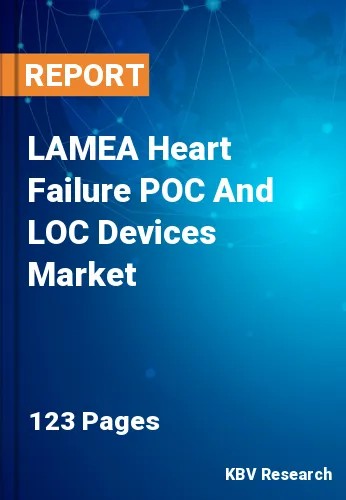The Latin America, Middle East and Africa Heart Failure POC And LOC Devices Market would witness market growth of 18.4% CAGR during the forecast period (2023-2030).
The presence of numerous clinical manifestations and frequently non-specific symptoms of heart failure has confounded the conventional diagnostic approach. As a result, numerous proof-of-concept (POC) tests have been developed, which has expedited the decision-making process for those at risk of developing cardiac disorders. Proof-of-concept (POC) assays effectively identify cardiac markers and other time-sensitive parameters, enabling the efficient mitigation of health disparities. For instance, to detect the risk of heart failure, the European Commission has funded the KardiaTool project, which aims to develop low-cost LOC assays for detecting biomarkers in saliva samples.
Moreover, the growth is restrained by the lack of a clearly defined reimbursement for point-of-use devices equipped with a cassette or cartridge capable of conducting multiple tests. To tackle this obstacle, the manufacturers formulate approaches to secure adequate reimbursement for point-of-care assays employing various analytes. A paradigm shift in diagnostic sectors from late-stage disease detection to early identification of diseases as a viable strategy to curb rising healthcare costs has driven the market. This shift has led to the development of disposable and low-cost LOC devices that integrate various sensors and associated accessories in a single space to detect cardiac biomarkers from a single specimen to evaluate the risk of having a heart attack.
Heart failure is a significant health concern globally, and the LAMEA region is no exception. Varied healthcare infrastructure across countries in the LAMEA region can impact the accessibility of advanced medical technologies. The federal budget 2022 allocated $15.8 billion (AED 58.931 billion) for public expenditure, of which 8.4% is given to healthcare. The UAE's Vision 2040 identifies healthcare as a priority sector, and the country will continue to be a desirable location for establishing a regional distribution center for healthcare services. The UAE has consistently invested significantly in its healthcare sector, leading to a high healthcare expenditure. Thus, the above aspects will expand the market growth across the region in the upcoming years.
The Brazil market dominated the LAMEA Heart Failure POC And LOC Devices Market by Country in 2022, and would continue to be a dominant market till 2030; thereby, achieving a market value of $4,592.1 Thousands by 2030. The Argentina market is showcasing a CAGR of 18.8% during (2023 - 2030). Additionally, The UAE market would register a CAGR of 18.1% during (2023 - 2030).
Based on Test Type, the market is segmented into Proteomic Testing, Metabolomic Testing, and Genomic Testing. Based on End Use, the market is segmented into Clinics, Hospitals, Laboratory, Assisted Living Healthcare Facilities, and Home. Based on Technology, the market is segmented into Microfluidics, Array-Based Systems, and Others. Based on countries, the market is segmented into Brazil, Argentina, UAE, Saudi Arabia, South Africa, Nigeria, and Rest of LAMEA.
Free Valuable Insights: The Worldwide Heart Failure POC And LOC Devices Market is Projected to reach USD 252.9 Million by 2030, at a CAGR of 16.4%
The market research report covers the analysis of key stake holders of the market. Key companies profiled in the report include Abbott Laboratories, Siemens Healthineers AG (Siemens AG), Danaher Corporation, F. Hoffmann-La Roche Ltd., BioMerieux S.A., QuidelOrtho Corporation, Trinity Biotech Plc, Jant Pharmacal Corporation, Abaxis, Inc. (Zoetis Services LLC) and Werfen, S.A.
By Test Type
By End Use
By Technology
By Country
Our team of dedicated experts can provide you with attractive expansion opportunities for your business.

